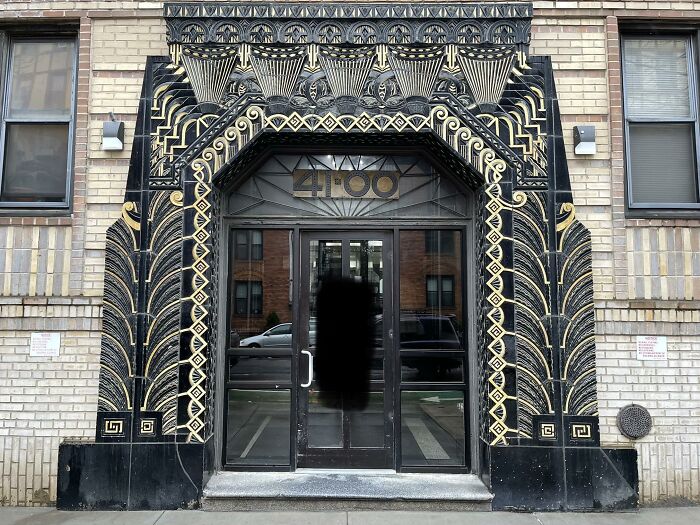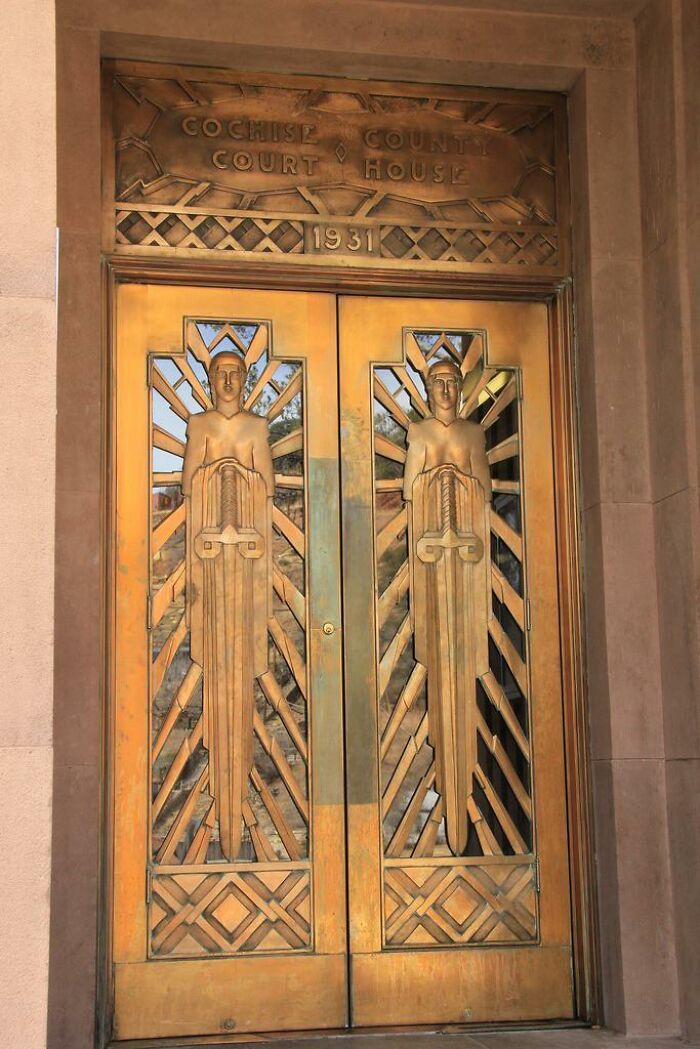Even though we encounter a thing every single day in our lives, it doesn't mean that from time to time it can't surprise us. Let's take doors, for instance. Some of them can be ordinary, something you see basically everywhere you go, but others can mesmerize you with their beauty.
Art Deco doors, which today's list is made up of, are a perfect example of that. There's a reason why many people love this style – it's fascinating. So, it's no surprise that these doors are too. So, let's walk through them, shall we?
More info: X
This post may include affiliate links.
Eastern Columbia Building, Los Angeles (1930)
Marine Building, Vancouver (1930)
Tuschinski Theatre, Amsterdam (1931)
This one is really nice. Those Amsterdamarians know how to build.
Some people are obsessed with doors. Yes, you read that right. Like this person, who wrote about having a “peculiar fascination about doors.” They said that every door has a story to tell and they’re eager to hear these stories. Quite philosophical, isn’t it?
Well, there are even more philosophical reasons why folks tend to get this obsession. For instance, a door stands like a threshold of possibility. What we mean by this is that it can be viewed as more than just a physical barrier – it can also be a metaphorical gate leading to various possibilities, hence the name.
National Tobacco Company Building, New Zealand (1932)
Boston Avenue Methodist Church, Tulsa (1929)
La Villa Empain, Brussels (1934)
Behind every door, some choices can shape our lives. That means that opening a door carries the symbolic meaning of new experiences. Thus, it leads to self-discovery – new people, passions, and personal growth overall.
Those are just a few philosophical explanations of why people develop enthusiasm for the concept of doors. At the same time, not every person is a fan of philosophy. There are plenty of reasons for this: some simply do not understand it, others are merely uninterested, and a few are afraid that it might prove that the values they have been living with until now are untrue.
One Lasalle St. Chicago, Illinois (1930)
Apartment Building, New York (19xx)
Manufacturers Trust Bank, New York (1954)
Little known fact: The Manufacturers Trust Company pioneered the practice of putting steps leading up to the elevator 🛗.
Still, even these people tend to like doors, but in an aesthetic sense. Aesthetics are made of various factors, including symmetry, colors, proportions, and so on. All of this creates a specific design, which is usually a part of a building's architecture. As you can see on this Wikipedia page, there are plenty of architectural styles that range through various time periods.
Today we’re going to focus on one of them – Art Deco. Some sources say it originated right before World War I (in the 1910s) in Paris, while others say it was in the 1920s. Either way, during the 1930s, it took Western Europe and the United States by storm. It represented luxury, glamor, and faith in progress. Sadly, due to the Great Depression, the style lost its intensity, while World War II fully ended its dominance.
Empire State Building, New York (1931)
Bacardi Buildings, Miami (1963)
You can see the reflection of the tripod and camera in the center door. And this is magnificent.
Cochise County Courthouse, Bisbee (1931)
At least with its dominance, the products were not completely lost. Of course, doors are no exception. Today’s list proves just that. These pictures were collected from an X thread dedicated to Art Deco doors posted by the @culturaltutor page, which has 1.7M followers. As the account’s bio says, it provides “a beautiful education,” and this thread is a perfect example of it.
But what makes a door Art Deco? Typically, original Art Deco doors are made of dark and heavy wood and have geometric patterns and extravagant light cutouts. Basically, the style is a blend of elegance and functionality. It gets inspiration from ancient Egyptian and Aztec motifs, Futurism, and Cubism. All of this makes them eye-catching.
Fisher Building, Detroit (1928)
La Maison Bleue, Angers (1929)
Apartment Building, Brooklyn (19xx)
Well, as can be seen in this list, they are certainly eye-pleasing, aren’t they? After all, the human brain is wired to like art, as doing so helps the release of dopamine, or the “feel good” hormone. It creates a feeling of calmness and pleasure and even improves memory.
This makes today’s list not only beautiful but also useful, and what’s better than something that’s both nice and functional, right?
Which of these doors would you like to walk through? Or maybe just admire? Don't forget to upvote them!
General Electric Building, New York (1931)
Guardian Building, Detroit (1929)
450 Sutter Street, San Francisco (1929)
70 Pine Street, New York (1930)
Carbide & Carbon Building, Chicago (1929)
They kind of borrowed the Chanel logo there. (Too bad they are not the doors to the executive restroom, I could have made a cool Chanel Number 2 joke.)
250 Cabrini Boulevard, New York (1936)
If you look very closely at those circular decorations you will see that they don't really resemble anything.
Chrysler Building, New York (1930)
They are very nice doors, but they had the perfect opportunity to mark the center door "LEXIT" and they didn't. (I bet if the Chrysler building was in France it would have happened.) EDIT: Come on pandas! Where is your sense of humor? This is a harmless little joke. Let's turn this around and shoot for 300 upvotes. We can do it!
7461 Beverly Blvd, Los Angeles (1958)
I bet if you ran your fingernail over those ridges it would make a cool sound. You could form a band and tell people you play the elevator door.
Koppers Building, Pittsburgh (1929)
70 Pine Street, New York (1932)
I'm getting Mayan Temple vibes from these two. (And cutting board vibes from that thing hanging on the wall.)
Beautiful! I've been lucky to see gorgeous Art Deco in Canada, such as Montreal's downtown area and a beautiful bank in Halifax. The guard there was told me that the decoration had been a work project during the Depression years. Banks may have been villains at times, but this one created jobs. In keeping with Halifax being a port city, the decor focussed on marine life and ships.
Beautiful! I've been lucky to see gorgeous Art Deco in Canada, such as Montreal's downtown area and a beautiful bank in Halifax. The guard there was told me that the decoration had been a work project during the Depression years. Banks may have been villains at times, but this one created jobs. In keeping with Halifax being a port city, the decor focussed on marine life and ships.

 Dark Mode
Dark Mode 

 No fees, cancel anytime
No fees, cancel anytime 










































































